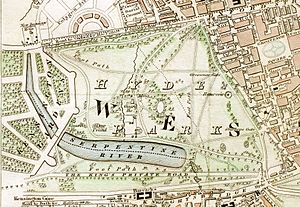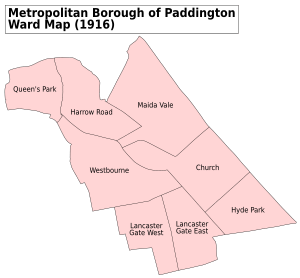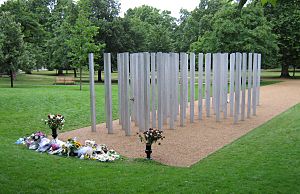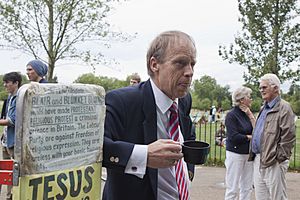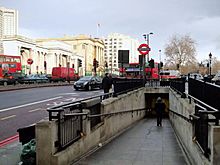Hyde Park, London facts for kids
Quick facts for kids Hyde Park |
|
|---|---|

Hyde Park and Kensington Gardens (in foreground)
|
|
| Lua error in Module:Location_map at line 420: attempt to index field 'wikibase' (a nil value). | |
| Type | Public park |
| Location | London, England |
| Area | 350 acres (140 ha) |
| Created | 1637 |
| Operated by | The Royal Parks |
| Status | Open year round |
|
National Register of Historic Parks and Gardens
|
|
| Official name | Hyde Park |
| Designated | 1 October 1987 |
| Reference no. | 1000814 |
Hyde Park is a Grade I-listed major park in Central London. It is the largest of four Royal Parks that form a chain from the entrance of Kensington Palace through Kensington Gardens and Hyde Park, via Hyde Park Corner and Green Park past the main entrance to Buckingham Palace. The park is divided by the Serpentine and the Long Water lakes.
The park was established by Henry VIII in 1536 when he took the land from Westminster Abbey and used it as a hunting ground. It opened to the public in 1637 and quickly became popular, particularly for May Day parades. Major improvements occurred in the early 18th century under the direction of Queen Caroline. Several duels took place in Hyde Park during this time, often involving members of the nobility. The Great Exhibition of 1851 was held in the park, for which The Crystal Palace, designed by Joseph Paxton, was erected.
Free speech and demonstrations have been a key feature of Hyde Park since the 19th century. Speakers' Corner has been established as a point of free speech and debate since 1872, while the Chartists, the Reform League, the suffragettes, and the Stop the War Coalition have all held protests there. In the late 20th century, the park was known for holding large-scale free rock music concerts, featuring groups such as Pink Floyd, The Rolling Stones and Queen. Major events in the park have continued into the 21st century, such as Live 8 in 2005, and the annual Hyde Park Winter Wonderland from 2007.
Contents
History
Hyde Park was created for hunting by Henry Vlll in 1536. He acquired the manor of Hyde from the canons of Westminster Abbey, who had held it since before the Norman Conquest; it was enclosed as a deer park and remained a private hunting ground until James I permitted limited access to gentlefolk, appointing a ranger to take charge. Charles I created the Ring (north of the present Serpentine boathouses), and in 1637 he opened the park to the general public.
In 1652, during the Interregnum, Parliament ordered the then 620-acre (250 ha) park to be sold for "ready money". It realised £17,000 with an additional £765 6s 2d for the resident deer.
In 1689, when William III moved his residence to Kensington Palace on the far side of Hyde Park, he had a drive laid out across its southern edge which was known as the King's private road. It still exists as a wide straight gravelled carriage track leading west from Hyde Park Corner across the southern boundary of Hyde Park towards Kensington Palace and now known as Rotten Row, possibly a corruption of rotteran (to muster), Ratten Row (roundabout way), Route du roi, or rotten (the soft material with which the road is covered). Public transport entering London from the west runs parallel to the King's private road along Kensington Gore, just outside the park. In the late 1800s, the row was used by the wealthy for horseback rides.
The first coherent landscaping was undertaken by Charles Bridgeman for Queen Caroline; under the supervision of Charles Withers, the Surveyor-General of Woods and Forests, who took some credit. It was completed in 1733 at a cost to the public purse of £20,000. Bridgeman's piece of water, the Serpentine, formed by damming the little Westbourne that flowed through the park, was not truly in the Serpentine "line of beauty" that William Hogarth described, but merely irregular on a modest curve. The 2nd Viscount Weymouth was made Ranger of Hyde Park in 1739 and shortly after began digging the Serpentine lakes at Longleat. The Serpentine is divided from the Long Water by a bridge designed by George Rennie (1826).
One of the most important events to take place in the park was the Great Exhibition of 1851. The Crystal Palace was constructed on the south side of the park. The public did not want the building to remain after the closure of the exhibition, and its architect, Joseph Paxton, raised funds and purchased it. He had it moved to Sydenham Hill in South London.
Another significant event was the first Victoria Cross investiture, on 26 June 1857, when 62 men were decorated by Queen Victoria in the presence of Prince Albert and other members of the Royal Family, including their future son-in-law Crown Prince Frederick of Prussia, later Emperor Frederick III.
On 20 July 1982 in the Hyde Park and Regents Park bombings, two bombs linked to the Provisional Irish Republican Army caused the death of eight members of the Household Cavalry and the Royal Green Jackets and seven horses.
Grand Entrance
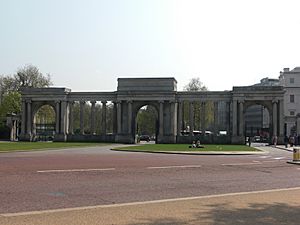
At the age of twenty-five, Decimus Burton was commissioned by the Office of Woods and Forests to carry out a series of work "to bring Hyde Park within the monumental orbit of Buckingham Palace". He laid out the paths and driveways and designed a series of lodges, the Screen/Gate at Hyde Park Corner (also known as the Grand Entrance or the Apsley Gate) (1825) and the Wellington Arch (1826–8) . The Screen and the Arch originally formed a single composition, designed to provide a monumental transition between Hyde Park and Green Park, although the arch was later moved. An early description reports:
"It consists of a screen of handsome fluted Ionic columns, with three carriage entrance archways, two foot entrances, a lodge, etc. The extent of the whole frontage is about 107 ft (33 m). The central entrance has a bold projection: the entablature is supported by four columns; and the volutes of the capitals of the outside column on each side of the gateway are formed in an angular direction, so as to exhibit two complete faces to view. The two side gateways, in their elevations, present two insulated Ionic columns, flanked by antae. All these entrances are finished by a blocking, the sides of the central one being decorated with a beautiful frieze, representing a naval and military triumphal procession. This frieze was designed by Mr. Henning, junior, the son of Mr. Henning who was well known for his models of the Elgin marbles. The gates were manufactured by Messrs. Bramah. They are of iron, bronzed, and fixed or hung to the piers by rings of gun-metal. The design consists of a beautiful arrangement of the Greek honeysuckle ornament; the parts being well defined, and the raffles of the leaves brought out in a most extraordinary manner."
Features
Sites of interest in the park include Speakers' Corner (located in the northeast corner near Marble Arch), close to the former site of the Tyburn gallows, and Rotten Row, which is the northern boundary of the site of the Crystal Palace. South of the Serpentine is the Diana, Princess of Wales memorial, an oval stone ring fountain opened on 6 July 2004. To the east of the Serpenertine, just beyond the dam, is London's Holocaust Memorial. The 7 July Memorial in the park commemorates the victims of 7 July 2005 London bombings.
A botanical curiosity is the Weeping Beech, Fagus sylvatica pendula, cherished as "the upside-down tree". Opposite Hyde Park Corner stands one of the grandest hotels in London, The Lanesborough (Formerly—until the early 1970s—St George's Hospital). Stanhope Lodge (Decimus Burton, 1824–25) at Stanhope Gate, demolished to widen Park Lane, was the home of Samuel Parkes who won the Victoria Cross in the Charge of the Light Brigade. After leaving the army, Parkes became inspector of the park's constables, and died in the lodge on 14 November 1864. A rose garden, designed by Colvin & Moggridge Landscape Architects, was added in 1994. An assortment of unusual sculptures are scattered around the park, including: Still Water, a massive horse head lapping up water; Jelly Baby Family, a family of giant Jelly Babies standing on top of a large black cube; and Vroom Vroom, which resembles a giant human hand pushing a toy car along the ground.
Debates
Hyde Park's Speakers' Corner has acquired an international reputation for demonstrations and other protests due to its tolerance of free speech. In 1855, a protest at the park was organised to demonstrate against Robert Grosvenor's attempt to ban Sunday trading, including a restriction on pub opening times. Karl Marx observed approximately 200,000 protesters attended the demonstration, which involved jeering and taunting at upper-class horse carriages. A further protest occurred a week later, but this time the police attacked the crowd.
In 1867 the policing of the park was entrusted to the Metropolitan Police, the only royal park so managed, due to the potential for trouble at Speakers' Corner. A Metropolitan Police station ('AH') is situated in the middle of the park. The 1872 Parks Regulation Act created positions of "park keeper" and also provided that "Every police constable belonging to the police force of the district in which any park, garden, or possession to which this Act applies is situate shall have the powers, privileges, and immunities of a park-keeper within such park, garden, or possession."
Concerts
See Also: List of concerts in Hyde Park
Local residents have become critical of Hyde Park as a concert venue, due to the sound levels, and have campaigned for a maximum sound level of 73 decibels. In June 2012, Bruce Springsteen and Paul McCartney found their microphones switched off after Springsteen had played a three-hour set during the Park's Hard Rock Calling festival, and overshot the 10:30pm curfew time.
Other Events
On 18 September 2010, Hyde Park was the setting for a prayer vigil with Pope Benedict XVI as part of Pope Benedict XVI's visit to the United Kingdom, attended by around 80,000 people.
Since 2007, Hyde Park has played host to the annual Winter Wonderland event.
Transport
There are five London Underground stations located on or near the edges of Hyde Park and Kensington Gardens (which is contiguous with Hyde Park). In clockwise order starting from the south-east, they are:
- Hyde Park Corner (Piccadilly line)
- Knightsbridge (Piccadilly line)
- Queensway (Central line)
- Lancaster Gate (Central line)
- Marble Arch (Central line)
Bayswater tube station, on the Circle and District lines, is also close to Queensway station and the north-west corner of the park. High Street Kensington tube station, on the Circle and District is very close to Kensington Palace located on the Southwest corner of Kensington Gardens. Paddington station, served by Bakerloo, Circle and District, and Hammersmith & City lines, is close to Lancaster Gate station and a short walk away from Hyde Park.
Several main roads run around the perimeter of Hyde Park. Park Lane is part of the London Inner Ring Road and the London Congestion Charge zone boundary. The A4, a major road through West London, runs along the southeastern edge of the park, while the A5, a major road to Milton Keynes and the Midlands runs northwest from Marble Arch.
Transport within the park for people lacking mobility and disabled visitors is provided free of charge by Liberty Drives, located at Triangle Carpark.
Cycle Superhighway 3 (CS3) begins at Lancaster Gate, on the northern perimeter of Hyde Park. It is one of several TfL-coordinated cycle routes to cross the Park. CS3 also crosses Hyde Park Corner on its route towards Westminster and the City of London. The route opened in September 2018 and is signposted and cyclists are segregated from other road traffic on wide cycle tracks.
Sports
Hyde Park contains several sporting facilities, including several football pitches and a Tennis centre. There are numerous cycle paths, and horse riding is popular.
In 1998 British artist Marion Coutts recreated Hyde Park, along with Battersea and Regent's Park, as a set of asymmetrical ping-pong tables for her interactive installation Fresh Air.
For the 2012 Summer Olympics, the park hosted the triathlon, which brothers Alistair Brownlee and Jonathan Brownlee took the Gold and Bronze medals for Team GB, and the 10 km open water swimming events. The park has also hosted the ITU World Triathlon Grand Final.
Images for kids
-
The Hamilton–Mohun Duel of 1712. Charles Mohun, 4th Baron Mohun fighting James Hamilton, 4th Duke of Hamilton in Hyde Park; both lost their lives.
-
Hyde Park, 1890, by Camille Pissarro, showing the footpath along the southern bank of the Serpentine
-
Jacob Epstein's Rima sculpture in Hyde Park
-
Pink Floyd performing at Live 8 in Hyde Park, 2 July 2005, their last of several gigs at the park over their career
See also
 In Spanish: Hyde Park para niños
In Spanish: Hyde Park para niños


